
Ground Objects
In the past, a Ground Object was just what its name implies: a single object that was used for ground in a world. It could be as simple as a repeating panel, or as complex as a multi-building city. But making the complex ones was tedious and often times a matter of trial and error, and with the advent of terrain, the ground object almost became obsolete. In comes the AWG (a feature used to save groups of objects). It changed the Ground Object forever.
How An AWG Can Change The Landscape
It's been almost 5 years since AWGs became a feature in the Active Worlds browser. It's been an invaluable and versatile addition to the toolbox, making copying, saving, and replicating builds as simple as chair01.rwx. This article assumes that you are familiar with making AWGs. If not, take a look here: https://www.activeworlds.com/newsletter/0208/020801.html
Now, if you're ready, let's take a look at just what AWGs have done to make ground objects indispensable.
Allows For Spectacular Vistas That Don't "Pop"
Take a look at this picture. Can you spot the pieces that are part of the ground object?
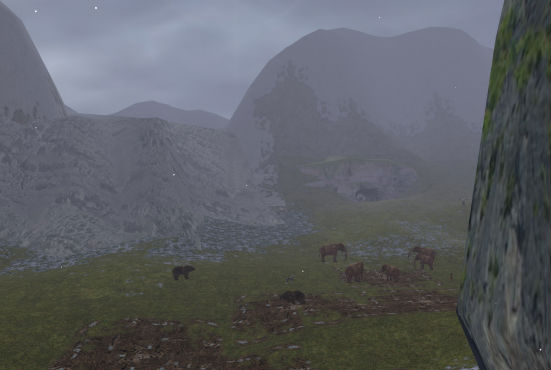
If you said the cave, the glacier, and the rock cliff (on the right side of the picture), you get a gold star. The individual objects were originally built in the world and a propdump was then taken and made into an AWG (This can be done by simply stripping out the "propdump version x" title from the propdump.txt and any object lines you don't want as part of your ground object). Zip it up, put it in the "Groups" folder of the world's object path, and then use the AWG as the ground object in the world. Why is this advantageous? The rock cliffs and glaciers are so massive in size (compared, to say, a woolly mammoth) that they tend to "pop" into view as a person runs around the world, disrupting the feel of the world. Ever have a glacier "pop" in front of you? It's not pretty. Making them into the ground object allows the cliffs and glaciers to be viewed from a great distance without that popping effect. This also worked nicely for the caves, since the students needed to find them easily for their projects and could spot the caves way across the valley.
Covering Terrain Holes
Anyone who has worked with building underground tunnels has run into the problem of holes in the terrain. You punch the holes at the entrances to caves and tunnels, and then you're left with this eyesore from a distance.
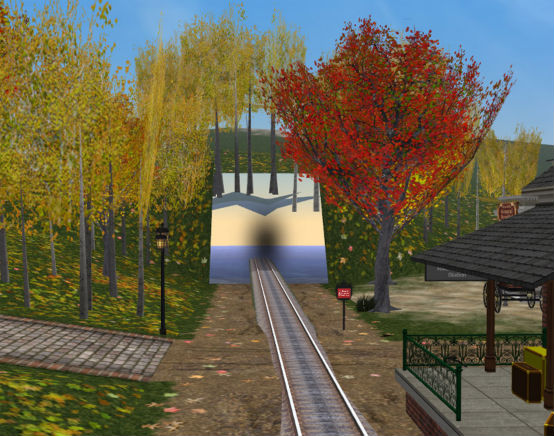
The terrain is ever present but the object covering the entrance isn't close enough to load. Thus the hole. But by putting the entry objects into an AWG ground object, this problem is solved.
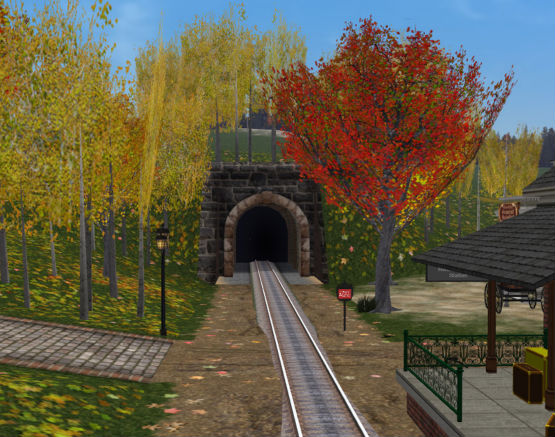
The caves from the Ice Age picture above also covered holes in the terrain. The look is much more gratifying and seamless without the gapping terrain holes.
Allows Commands On Pieces of the Ground Object
Let's say you have a train that you to roll down the track, or a wagon and its driver to ride down a road in town, or perhaps you need to have a windmill spinning in the distance. All of these require the use of building commands. In the past, you couldn't apply commands to a ground object. But AWG ground objects allow room for the use of commands. All of the following examples have been used in AWG ground objects.
The lights used in a recent ground object make use of "create alpharef off" so that the mask reacts more like light cast from a lamp instead of a halo.

The wagon in this ground object makes use of "create rotate" for the turning wheels and "create seq" makes the driver sit in the wagon and the horse plod down the street. We added the wagon and its attendant items to the ground object because they had a tendency to pop in and out of view as they moved away from the viewer. It was disconcerting.
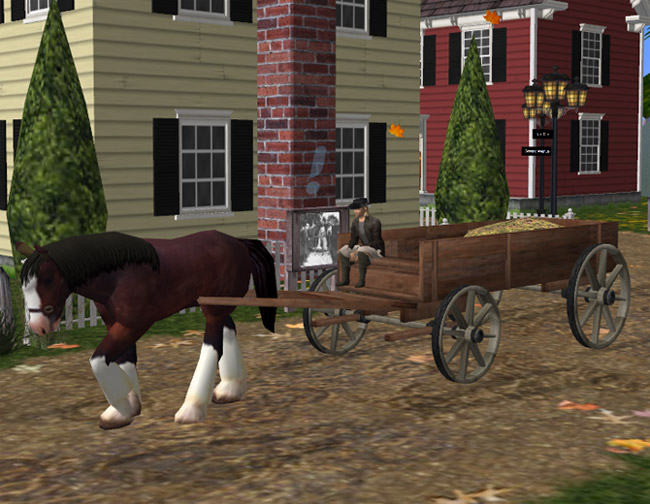
So AWGs let us add life to our ground objects by allowing us to use commands. You might be stopping me right now, wondering, "Didn't you use "create move" to have the wagon roll down the street? Astute observation. If anyone has ever tried using "create move" in an AWG ground object, it doesn't work. Every other command works in an AWG ground object, but for whatever reason, "create move" fails to move the object that it is on. Then how did we get the wagon to move down the street? Artist Secret Tip No. 32 is being divulged now.
Using Move Command In Conjunction With AWG Ground Object
Because we can use "create name" on objects in an AWG ground object, we start by giving everything that is part of the wagon a "create name wagon1". This includes the horse, the wagon, the wheels, and the driver. Then we put these items into our AWG ground object.
We next build a set of underground boxes that go the length of the road. These do not get put in the AWG ground object.
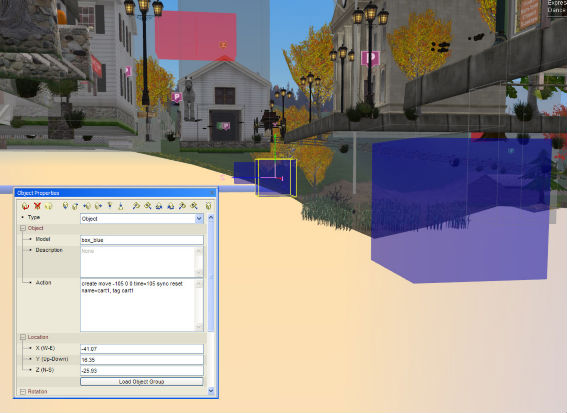
The action box displays: create move -105 0 0 time=105 sync reset name=cart1, tag cart1
These boxes are spaced about 45 meters apart all the way down the length of the road. This way, the viewer will always have at least one of these boxes in their view, even if their visibility is set relatively low, and that is key. These boxes are going to transfer the move command onto the wagon objects in the AWG ground object via the "name" command.
You'll notice in the Object Properties box that we've put the move command set to react to anything named "cart1". And presto, our wagon moves down the road! You'll also note that there is a "create tag cart1" in the action line of that box. This was copied over from the train that rolls down the tracks of our tunnel picture. The train has a particle for it's lantern light that has to move with the rest of the train. To get the particle to turn on, we have to use "create tag cart1". This part does absolutely nothing for the wagon though, since it has no particle, so it is unnecessary. And that's the secret to getting objects in your AWG ground object to move.
In Conclusion
Now you have the knowledge necessary to make and use AWGs as part of a ground object. One thing to always keep in mind with your ground objects: choose only what is absolutely necessary to put on your ground object, and keep it as light as possible. A ground object keeps things in our visibility for much farther than traditional objects. This can create a huge lag bomb if there is way too much on an AWG ground object. But used prudently, an AWG ground object can add life, beauty, and a fluid appearance to your world.
Have an artistic topic you'd like to see discussed, or a question that desires answering in a future article? Send it all over! stacey at activeworlds.com (yes, that's Stacey with a y!)
